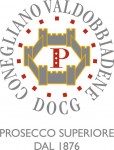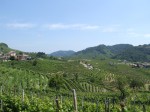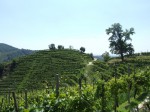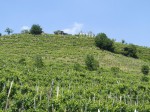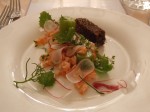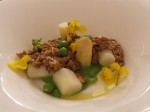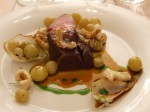Pro Prosecco DOCG!
Anti Prosecco DOC?
Pro Prosecco DOCG!
Anti Prosecco DOC?
De maand waarin (in Nederland) de meeste mousserende wijn wordt verkocht, nadert zijn commerciële hoogtepunt. Vele duizenden bruisende wijnen vinden hun weg van het, al dan niet digitale, schap naar een tafel gevuld met feestelijke gerechten, oliebollen of ander culinair vuurwerk. De keuze voor de soort en/of het merk, is vaak willekeurig, maar gelukkig soms ook bewust. 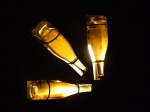
In het prijsbewuste (of gierige?) Nederland, wordt vooral naar de kosten van zo’n fles gekeken. Niet vreemd, wat wie kent het precieze verschil, en wie is in staat om het ook daadwerkelijk te proeven?
Prosecco
Enkele jaren geleden ontdekte de Nederlandse consument Prosecco. Het bleek de nieuwe landelijke trend na rosé en de verkoop steeg in korte tijd met zo’n 700%. Nederlanders zouden geen Nederlanders zijn, als we niet vooral door het aantrekkelijke prijskaartje van Prosecco zouden zijn verleid. Waar Champagne al snel minstens drie tientjes kost, betaal je voor een Prosecco soms niet eens € 5,00.
Maar waar komt dat prijsverschil vandaan en wat betekent het in de praktijk? 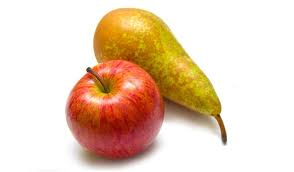 De voornaamste oorzaak van de veel lagere prijs is het feit dat Prosecco en Champagne alleen gemeen hebben dat ze allebei mousserende wijnen zijn, zoals een Citroen 2CV en de Bugatti Veyron ook beiden auto’s zijn. Een verdere vergelijking is onjuist en zinloos. Prosecco komt immers niet uit Frankrijk, niet uit de Champagne-streek, wordt niet gemaakt van dezelfde druiven en evenmin volgens dezelfde methode.
De voornaamste oorzaak van de veel lagere prijs is het feit dat Prosecco en Champagne alleen gemeen hebben dat ze allebei mousserende wijnen zijn, zoals een Citroen 2CV en de Bugatti Veyron ook beiden auto’s zijn. Een verdere vergelijking is onjuist en zinloos. Prosecco komt immers niet uit Frankrijk, niet uit de Champagne-streek, wordt niet gemaakt van dezelfde druiven en evenmin volgens dezelfde methode.
Prosecco wordt gemaakt in de Italiaanse Veneto,  van de gelijknamige druif en met de Charmat-techniek. Omdat de populariteit van Prosecco wereldwijd explosief is toegenomen, is de productie het laatste decennium sterk uitgebreid. Uiteraard zijn hier wijngaarden voor nodig en bij gebrek aan grond in de heuvels rond de plaatsen Valdobbiadene en Conegliano, heeft uitbreiding vooral plaatsgevonden in de vlakten ver voorbij het klassieke gebied tot zelfs in Friuli.
van de gelijknamige druif en met de Charmat-techniek. Omdat de populariteit van Prosecco wereldwijd explosief is toegenomen, is de productie het laatste decennium sterk uitgebreid. Uiteraard zijn hier wijngaarden voor nodig en bij gebrek aan grond in de heuvels rond de plaatsen Valdobbiadene en Conegliano, heeft uitbreiding vooral plaatsgevonden in de vlakten ver voorbij het klassieke gebied tot zelfs in Friuli.
 DOCG
DOCG
Deze gebieden zijn niet of nauwelijks met elkaar te vergelijken qua terroir en het verschil tussen de wijnen uit beide streken is dan ook groot. Om de kwaliteit en het karakter van de wijnen uit het klassieke district te beschermen, zijn in 2009 strenge regels opgelegd die een DOCG-status voor Prosecco’s uit het classico-gebied rechtvaardigen. Hun formele titel is sindsdien Conegliano Valdobbiadene Prosecco Superiore DOCG, soms aangevuld met de naam van een specifieke sub-regio (cru) zoals ‘Cartizze’of 1 van de 43 onderscheiden ‘Rive’ (zeer steile hellingen).
Glera
De wijnen uit de omringende gebieden kregen een lagere DOC-status, dit om het kwaliteitsverschil nog duidelijker aan te geven. Ook werd het verboden de naam van de Prosecco-druif te gebruiken om verdere verwarring en misbruik van de merknaam Prosecco tegen te gaan. Producenten mogen wel met dezelfde druif werken, maar moeten dan de historische naam van de druif gebruiken; Glera.
kwaliteitsverschil nog duidelijker aan te geven. Ook werd het verboden de naam van de Prosecco-druif te gebruiken om verdere verwarring en misbruik van de merknaam Prosecco tegen te gaan. Producenten mogen wel met dezelfde druif werken, maar moeten dan de historische naam van de druif gebruiken; Glera.
 Bar
Bar
Niet alleen de herkomst van de druif is bepalend voor het karakter en de kwaliteit van de wijn, ook het type speelt een rol. In het classico-gebied is een Prosecco DOCG doorgaans een spumante, d.w.z. een mousserende wijn met een druk van 3,5 tot 5,0 bar (Champagne, Franciacorta en TrentoDoc meestal tot 6 bar). In het DOC-district worden juist enorme hoeveelheden Frizzante gemaakt; een lichtere versie, meestal met een druk van 1,0 tot 2,5 bar, maximaal 3,5. Het is juist deze laatste groep Prosecco’s die we in de supermarkten vinden.
Charmat
Een ander onderscheidend kenmerk van Prosecco is de manier waarop hij gemaakt wordt. Geen 2e gisting en jarenlange rijping in individuele flessen, maar een korte 2e gisting gisting in grote roestvrijstalen tanks. Deze methode werd in 1910 uitgevonden door Eugène Charmat en inmiddels wereldwijd toegepast. Omdat de gisting en lagering kort is en veel minder arbeidsintensief, blijven de productiekosten beperkt. Dit verklaart voor het grootste deel het prijsverschil tussen een Prosecco en bijvoorbeeld een TrentoDoc.
in grote roestvrijstalen tanks. Deze methode werd in 1910 uitgevonden door Eugène Charmat en inmiddels wereldwijd toegepast. Omdat de gisting en lagering kort is en veel minder arbeidsintensief, blijven de productiekosten beperkt. Dit verklaart voor het grootste deel het prijsverschil tussen een Prosecco en bijvoorbeeld een TrentoDoc.
Zoet of droog
Tenslotte is het nog belangrijk om te weten dat een Prosecco van origine een niet geheel droge wijn is. het is momenteel erg trendy om drogere versies te maken, maar de charme van een Prosecco is juist zijn kleine zoetje. Het maakt de wijn laagdrempelig, goed doordrinkbaar en beter inzetbaar bij bijvoorbeeld zoetwatervis. De  Europese wetgeving rond de zoetheid van wijn is tamelijk verwarrend. Waar je bij ‘extra dry’ een extra droge wijn zou verwachten, heeft deze meestal een duidelijk proefbaar zoet. Extra Dry is de normale uitvoering van Prosecco en betekent dat de wijn tussen de 12 en 17 gram per liter restsuiker bevat. Volledigheidshalve: Brut betekent 0-12 gram en Dry 17-32 gram.
Europese wetgeving rond de zoetheid van wijn is tamelijk verwarrend. Waar je bij ‘extra dry’ een extra droge wijn zou verwachten, heeft deze meestal een duidelijk proefbaar zoet. Extra Dry is de normale uitvoering van Prosecco en betekent dat de wijn tussen de 12 en 17 gram per liter restsuiker bevat. Volledigheidshalve: Brut betekent 0-12 gram en Dry 17-32 gram.
 Vino in Villa
Vino in Villa
Elk jaar kunnen de internationale pers,

 inkopers en consumenten kennis maken met de nieuwe oogst van vrijwel alle producenten uit het Prosecco DOCG-gebied. Tijdens het evenement ‘Vino in Villa’ zijn tientallen wijnen te proeven en zijn de onderlinge verschillen in stijl en (eerlijk is eerlijk) ook kwaliteit duidelijk zichtbaar. Dit jaar werd extra aandacht besteed aan de inzetbaarheid van Prosecco DOCG in de gastronomie. De wijn lijdt nog altijd onder het vooroordeel dat het uitsluitend een simpel aperitief is bij gebrek aan een echte mousserende
inkopers en consumenten kennis maken met de nieuwe oogst van vrijwel alle producenten uit het Prosecco DOCG-gebied. Tijdens het evenement ‘Vino in Villa’ zijn tientallen wijnen te proeven en zijn de onderlinge verschillen in stijl en (eerlijk is eerlijk) ook kwaliteit duidelijk zichtbaar. Dit jaar werd extra aandacht besteed aan de inzetbaarheid van Prosecco DOCG in de gastronomie. De wijn lijdt nog altijd onder het vooroordeel dat het uitsluitend een simpel aperitief is bij gebrek aan een echte mousserende wijn; een probleem voor zowel de producenten als de consument. Een goede Prosecco kan immers veel meer betekenen. De wijn uitsluitend als niemendalletje beschouwen en schenken doet velen tekort.
wijn; een probleem voor zowel de producenten als de consument. Een goede Prosecco kan immers veel meer betekenen. De wijn uitsluitend als niemendalletje beschouwen en schenken doet velen tekort.
Chef
De uit Denemarken overgekomen chef Klavs Styrbæk van restaurant Kvægtorvet in  Odense (Fiona) zorgde voor een culinair feestje waarbij de pure Deense kookstijl en diverse Conegliano Valdobbiadene Prosecco Superiore DOCG centraal stonden. Het combineren van allerlei wijnen bij de gerechten bleek een boeiende exercitie; soms zeer geslaagd, soms ‘iets’ minder. Wel werd onomstotelijk vastgesteld dat Conegliano Valdobbiadene Prosecco Superiore DOCG beslist een interessant gastronomisch potentieel heeft.
Odense (Fiona) zorgde voor een culinair feestje waarbij de pure Deense kookstijl en diverse Conegliano Valdobbiadene Prosecco Superiore DOCG centraal stonden. Het combineren van allerlei wijnen bij de gerechten bleek een boeiende exercitie; soms zeer geslaagd, soms ‘iets’ minder. Wel werd onomstotelijk vastgesteld dat Conegliano Valdobbiadene Prosecco Superiore DOCG beslist een interessant gastronomisch potentieel heeft.
 Mijns inziens verdient Prosecco DOCG alle aandacht, veel meer dan Prosecco DOC, te vergelijken met Chablis Grand Cru versus Petit Chablis, Chianti Classico versus Chianti, de meeste Grand Cru Classe uit Bordeaux versus Bordeaux AC of toppers uit de Napa Valley, Apalta
Mijns inziens verdient Prosecco DOCG alle aandacht, veel meer dan Prosecco DOC, te vergelijken met Chablis Grand Cru versus Petit Chablis, Chianti Classico versus Chianti, de meeste Grand Cru Classe uit Bordeaux versus Bordeaux AC of toppers uit de Napa Valley, Apalta Valley en Stellenbosch versus bulkwijnen uit nabij gelegen wijndistricten. Natuurlijk zijn er verschillende goede Prosecco’s uit het DOC-gebied, maar voor mij gelden de volgende tien gulden regels waar het Prosecco DOCG en de vergelijking met Prosecco DOC en andere mousserende wijnen betreft:
Valley en Stellenbosch versus bulkwijnen uit nabij gelegen wijndistricten. Natuurlijk zijn er verschillende goede Prosecco’s uit het DOC-gebied, maar voor mij gelden de volgende tien gulden regels waar het Prosecco DOCG en de vergelijking met Prosecco DOC en andere mousserende wijnen betreft:
1. Prosecco komt niet uit Frankrijk en zeker niet uit het Champagne-gebied.
2. Alleen Prosecco wordt uitsluitend gemaakt van de Prosecco druif
(en dus niet van Chardonnay, Pinot Noir, Shiraz, Lambrusco, Chenin, Malvasia etc.)
3. Prosecco wordt gemaakt volgens de Charmat-methode en dus niet volgens de Metodo Classico.
4. Als we een goede Prosecco willen drinken, kiezen we een DOCG.
5. De kans op een goede Prosecco uit het DOCG-gebied is 80%
6. De kans op een matige Prosecco met DOC status is 80%
7. Als we een goede Prosecco willen drinken, kiezen we een Spumante i.p.v. een Frizzante (en zeker geen 9.5)
8. Realiseer je dat Prosecco van origine niet bedoeld is als strakdroge wijn
9. Drink Prosecco binnen een jaar na botteling (let dus op de L-code)
10. Hou van Prosecco DOCG, Champagne, TrentoDoc, Franciacorta etc. maar verwar en mix ze nooit
Tijdens de proeverij vielen verschillende wijnhuizen in positieve zin op. Een kleine selectie:
Adami, ‘Vigneto Giardino, Rive di Colbertaldo’, Valdobbiadene Prosecco Superiore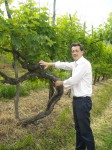 Spumante Dry DOCG
Spumante Dry DOCG
Weelderige geur die uitnodigt tot drinken door verleidelijke geur van ingemaakte peren en ander rijp wit fruit, vol van smaak, duidelijk zoet maar prachtige zuren zorgen voor uitstekende balans, sappig met mooie lengte, heerlijk bij niet te zoete desserts, patisserie en op allerlei andere momenten als je niet bang bent voor een beetje zoet
Bortolomiol, ‘Bandarossa’, Valdobbiadene Prosecco Superiore Spumante Extra Dry DOCG
Krachtige geur met veel accenten van appel en witte perzik, ook stevig van smaak, sappig met mooie fruittonen, subtiel bittertje en een lichte kruidigheid, eindigt rijk en zuiver, zoet is mooi ingepakt
 Foss-Marai, ‘Strada di Guia 109’,Conegliano Valdobbiadene Prosecco Superiore Spumante Extra Dry DOCG
Foss-Marai, ‘Strada di Guia 109’,Conegliano Valdobbiadene Prosecco Superiore Spumante Extra Dry DOCG
Volle, zuivere, frisse geur, bloesem, peer, zoete appel en lychees, breed van smaak, perfecte balans door mooie zuren, sappig en smaakvol.
smaak, perfecte balans door mooie zuren, sappig en smaakvol.
Onbegrijpelijk dat dit wijnhuis niet (breed) verkrijgbaar is in Nederland.
Malibràn, ‘Ruio’, Valdobbiadene Prosecco Superiore Spumante Brut DOCG
Fijne mousse, loepzuivere geur, fris en stuivend, bloesem en appel, elegant in geur en smaak, fijn bittertje, zeer fraai en doortastende afdronk
Perlage, ‘Col di Manza’, Conegliano Valdobbiadene Prosecco Superiore Spumante Extra Dry DOCG
Biologisch. Eigenzinnige stijl, heel schoon en natuurlijk met impressies van rijp fruit, wat hooi, lychees en peer; subtiel zoetje, krachtige, zuivere en redelijk droge afdronk, schoont het palet
Ruggeri, ‘Giustino’, Valdobbiadene Prosecco Superiore Spumante Extra Dry, DOCG
Floraal, goed intens, in geur en smaak met zachtzoete accenten van rijp wit fruit, prima zuurgraad geeft spanning, verleidelijk glas
Met dank aan:
Gheusis Srl
www.gheusis.com
In the Netherlands, most sparkling wine is sold in December and sales approach their commercial peak. Many thousands of bubbly wines find their way from a (often digital) shelf to a festive tables, loaded with lush menu’s, traditional Dutch ‘oliebollen’ or other culinary fireworks.
What people choose (type or brand) is often a coincidence, but also (and fortunately) sometimes also a deliberate choice. In the price-conscious (or greedy?) Netherlands, people mainly focus on the (lowest) price of a bottle. Not strange, because who knows the differences are and who is able to actually taste them?
Prosecco
A few years ago the Dutch consumer discovered Prosecco. It was the new national trend after rosé and sales increased in a short time by about 700%. The main reason was a very attractive price tag. Where Champagne costs at least € 30,00 many Prosecco’s can be found for less than € 5,00.
People get confused by all these price differences. Where do they come from and what does it really mean in our everyday practice? The main reason is off course the fact that they are completely different products. The only thing Prosecco and Champagne have in common is the fact that they are both sparkling wines, just like a Citroen 2CV and the Bugatti Veyron are also both cars. Any other comparison is unjustified and meaningless. Prosecco is not from France, not from the Champagne region, is not made with the same grapes, nor the same method.
Prosecco is made in the Italian Veneto region, from the Prosecco grape and with the Charmat technique. As the worldwide popularity of Prosecco has increased explosively, production expanded significantly over the past decade. Due to the lack of enough (new) vineyards in the hills around the towns Valdobbiadene and Conegliano where Prosecco originated, expansion has occurred mainly in the plains of the Veneto and even in Friuli.
DOCG
These areas cannot be compared in terms of soil and the difference between the
wines from both regions is substantial. In 2009 strict rules were imposed to ensure and protect the quality and character of the wines from the traditional district. It resulted in a justified DOCG status for Prosecco’s from this Classico area. Their formal title Conegliano Valdobbiadene Prosecco Superiore DOCG, is sometimes supplemented by the name of a specific sub-region as ‘Cartizze’ or 1 of the 43 ‘Rive’ (specific vineyards on steep slopes, crus).
Glera
The wines from the surrounding areas had a lower DOC status, this to accentuate the difference in quality. It also prohibited the use of the name Prosecco as grape for other wines to avoid confusion and abuse of the brand Prosecco. Producers are allowed to work with the same grape, but have to use the historical name of the grape; Glera.
Bar
Not only the origin of the grape determines the character and quality of the wine, also the style/type is important. In the classico area a DOCG Prosecco usually is a ‘spumante’, a sparkling wine with a pressure of 3.5 to 5.0 bar (Champagne, Franciacorta and TrentoDoc usually go up to 6 bar). In the DOC district huge amounts of Frizzante are made, a lighter version, usually with a pressure of 1.0 to 2.5 bar (up to 3.5). It is this latter group of prosecco’s that we normally find in supermarkets.
Charmat
Another distinctive feature of Prosecco, is the way it is made. No 2nd fermentation and long aging in individual bottles, but a brief second fermentation in closed stainless steel tanks. This method was invented in 1910 by Eugène Charmat and is now used worldwide. Because the fermentation and aging is short and much less labor intensive, the production costs remain limited. This explains for the most part the price difference between a Prosecco and, for instance, a TrentoDoc.
Sweet or dry
Finally, it is important to know that a Prosecco originally was not a completely dry wine. It is currently trendy to make drier versions, but the charm of a classic Prosecco DOCG is it’s slightly sweet accent. It makes the wine round, soft, easy to approach, very drinkable and more employable at the table with for example freshwater fish. The European legislation on the sweetness of wine is rather confusing. The term ‘extra dry’ suggests an extra dry wine, but it usually is a wine with a distinct sweetness. Extra Dry is the normal style of a classic Prosecco DOCG and will contain between 12 and 17 grams of residual sugar per liter. Brut means 0-12 grams and ‘Dry’ 17-32 grams. The last one not dry at all; maybe some politicians can explain why….
Vino in Villa
Every year, the international press, buyers and consumers are given the opportunity to get acquainted with the latest vintage of almost every wine of nearly all producers in the Prosecco DOCG area. During the event, “Vino in Villa’, dozens of wines can be tasted and the differences in style and also quality become clearly visible.
This year special attention was given to the potential of Prosecco DOCG in gastronomy. The wine still suffers from the image of being just a simple aperitif or a substitute for ‘real sparkling wines’. A problem for both producers and consumers. A good Prosecco can be much more, as is easily proven.
Danisch chef Klavs Styrbæk of the famous restaurant Kvaegtorvet in Odense (Fiona) came over top demonstrate how well the pure Danish style of cooking can be paired with Conegliano Valdobbiadene Prosecco Superiore DOCG. Combining various wines with several dishes was a fascinating exercise, sometimes successful, sometimes less. But, without a doubt, it confirmed that Conegliano Valdobbiadene Prosecco Superiore DOCG certainly has an interesting gastronomic potential.
I’m convinced that Prosecco DOCG deserves a lot more attention and recognition than Prosecco DOC, like Chablis Grand Cru has a lot more to offer than Petit Chablis, Chianti Classico to Chianti, most Grand Cru Classé from Bordeaux to Bordeaux AC or the best wines from the Napa Valley, Apalta Valley and Stellenbosch compared to bulk wines from nearby wine districts.
Of course there are several examples of good wines from the Prosecco DOC area, but for me the following ten golden rules where the Prosecco DOCG compared with Prosecco DOC and other sparkling wine:
1. Prosecco is not French, and certainly not from the Champagne region.
2. Only Prosecco is made with the Prosecco grape (and not with Chardonnay, Pinot Noir, Shiraz, Lambrusco, Chenin, Malvasia, etc.)
3. Prosecco is made by using the Charmat method and not the Metodo Classico.
4. If we want to drink a good Prosecco, we choose a DOCG.
5. The chance of a good Prosecco DOCG is 80%
6. The chance of a ‘less good’ Prosecco DOC is 80%
7. If we want to drink a good Prosecco, we choose a Spumante instead of a Frizzante (and certainly not a 9.5)
8. Prosecco was not intended to be a bone dry wine
9. Drink Prosecco within one year after bottling (so watch the L code)
10. Love DOCG Prosecco, Champagne, TrentoDoc, Franciacorta etc. but never confuse and mix them
During the tasting several wineries stood out. A small selection:
Adami, “Vigneto Giardino, Rive di Colbertaldo ‘, Valdobbiadene Prosecco Superiore DOCG Spumante Dry
Lush, fragrances that invite you to drink, pear and other ripe white fruit, full of flavor, clearly a sweet touch but with the right acidity for an excellent balance, juicy with good length, great with not too sweet desserts, pastries and a variety of other dishes or at other moments if you are not afraid of a little sweet
Bortolomiol, “Banda Rossa”, Valdobbiadene Prosecco Superiore DOCG Spumante Extra Dry
Powerful aroma with many accents of apple and white peach, also rich in the mouth, juicy with nice hints of various fruit, subtle bitter touch and slightly spicy, long finish, pure
Foss Marai-, “Strada di Guia 109 ‘, Conegliano Valdobbiadene Prosecco Superiore DOCG Spumante Extra Dry
Full and pure, fresh fragrances of blossom, pear, sweet apple and lychees, perfectly balanced by good acidity, juicy and full of flavors.
Impossible to understand why this winery is still not (widely) available in the Netherlands.
Malibran, “Ruio ‘, Valdobbiadene Prosecco Superiore DOCG Brut Spumante
Fine mousse, flawless scent, fresh and fine, apple and blossom, elegant in smell and taste, nice bitter accent, beautiful and bold finish
Perlage, “Col di Manza,” Conegliano Valdobbiadene Prosecco Superiore DOCG Spumante Extra Dry
Organic. Quirky style, very clean and with impressions of ripe fruit, some hay, lychee and pear, subtle sweetness, powerful, clean and fairly dry finish, cleans the palet
Ruggeri, “Giustino”, Valdobbiadene Prosecco Superiore Spumante Extra Dry DOCG
Floral, good intense in aroma and flavor with soft sweet notes of ripe white fruit, fine acidity gives power, tempting glass
Thanks to:
Gheusis Srl
www.gheusis.com
